Jeanneau Sun Fast 30 OD on test: New regatta one-design class without compromises
Michael Good
· 26.01.2024
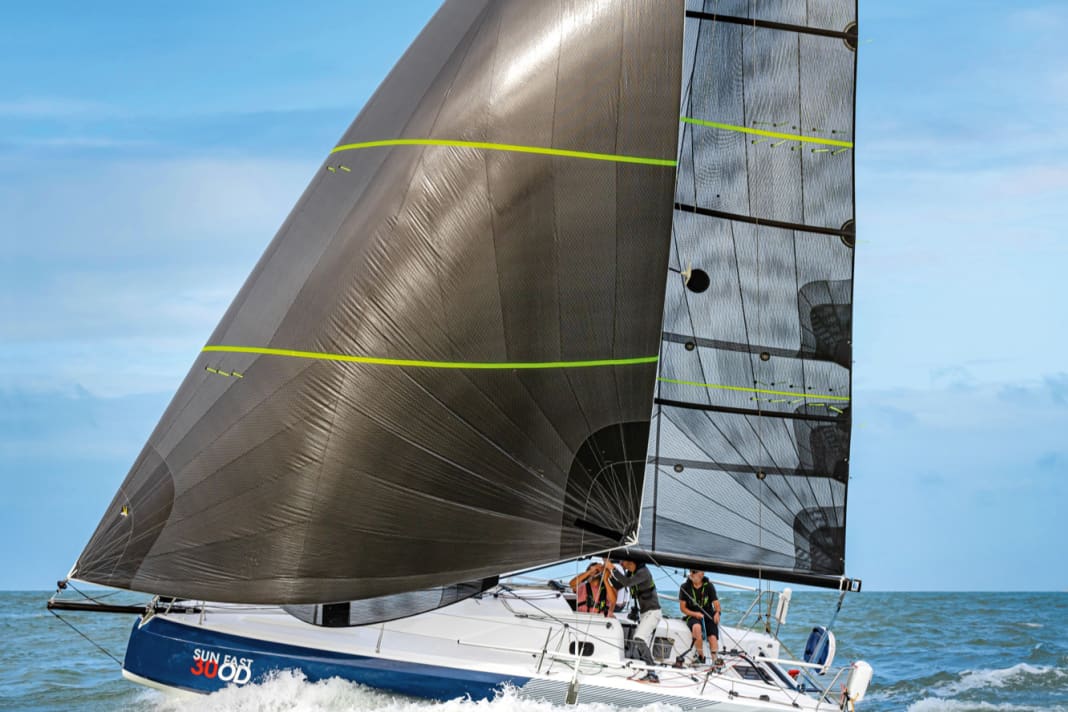





- boot Düsseldorf 2024: Hall 16, Stand B18
A strict one design is basically a blessing for regatta sailors and is highly attractive. It guarantees maximum equality of opportunity and limits the possibilities of being able to buy success on the course with lavish budgets, so to speak. In the standardised class, there are no material battles; instead, talent and ability determine victory and defeat. And because the development costs can be passed on to the expected high unit numbers, prices can ultimately be kept reasonable, which in turn increases interest and therefore sales figures. A win-win situation for everyone.
For racing yachts, sports boats or dinghies that sail in the standardised class and are subject to consistent class regulations, unrestricted conformity usually applies. This means that anything that is not specifically permitted within the rules is generally prohibited. However, One Design also means that the possibilities for individualisation are limited to an absolute minimum.
The Sun Fast 30 OD fills the gap between the Mini 6.50 and Class 40
The new, ultimate one-size-fits-all racer comes from the western French co-operation between large series manufacturer Jeanneau in the Vendée and Multiplast, the major specialist for ocean racing in Brittany. The product of this promising alliance is now being launched on the market under the name Jeanneau Sun Fast 30 One Design and is intended to position itself in the gap between the Mini 6.50 and Class 40 regatta classes. However, this attractive niche is already quite prominent and successfully occupied, for example with the Dehler 30 One Design from Germany or the two somewhat larger competitors Figaro 3 from Beneteau and the Sun Fast 3300, also from Jeanneau. However, these models have a very strong focus on long-distance single and double-handed racing and are also seen as a springboard for sailing careers in the Class 40 or the Imoca 60.
In contrast, the concept of the Sun Fast 30 One Design is much more geared towards team racing and for shorter coastal courses. An international class association is now being set up and has already put together an attractive and top-class regatta programme for 2024. The project initiators are also planning a new edition of the popular stage classic Tour de France à la Voile (Tour Voile). The successful series could take place as early as 2024, or by 2025 at the latest, with the new boat from Jeanneau/Multiplast.
The goal: a new standardised class around 30 feet
The project for the Sun Fast 30 One Design is based on the initiative of the UNCL (Union Nationale pour la Course au Large), the national association of ocean sailors in France, in co-operation with the RORC (Royal Ocean Racing Club) in England and the Storm Trysail Club in America. All three organisations have joined forces with the aim of establishing a new regatta unit class with a hull length of 30 feet (Class 30). The design competition organised for this purpose was ultimately won by the VPLP office in France. The contract for series production of the racer was awarded to large-scale manufacturer Jeanneau, which was allowed to integrate the model into its sporty Sun Fast programme. The Multiplast shipyard, which was originally supposed to build the boat, will retain the construction supervision and contribute its experience in the development of projects for ocean racing.
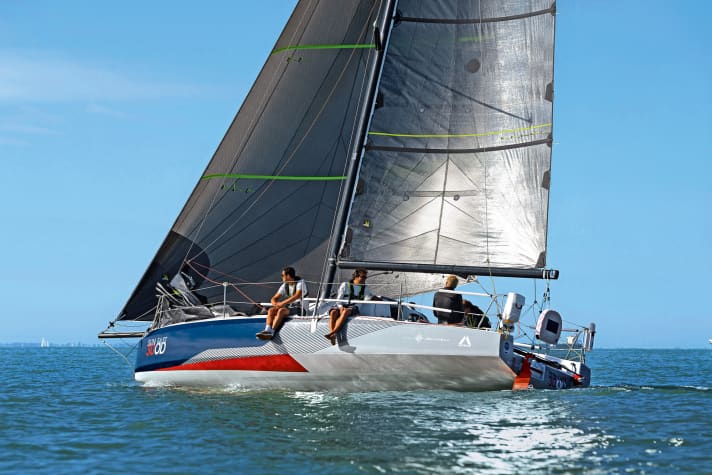
The design for the Sun Fast 30 One Design, which is not subject to any common equalisation formulas such as IRC or ORC, is quite radical, with a strong reference to the designs of the current Class 40 and Imoca 60 racers. The most striking feature is the full front section with the pronounced scow bow and the continuous chine. The extremely wide, flat underwater hull at the front is intended to help the boat to planing faster, especially on downwind courses, similar to a surfboard. This is how VPLP designer Antoine Lauriot Prévost, who is responsible for the design and is on board for the YACHT test off La Rochelle, describes it.
High potential and stiff sailing performance
As nominated boat for the European Yacht of the Year award the small racer from Jeanneau/ Multiplast is available to the international jury for the first test runs, in very different conditions. While the wind conditions for the test with the YACHT are unfortunately very weak with a maximum of ten knots, other colleagues are lucky for their test slots and can sail the boat in more wind. Ultimately, the jury members agree on one point: the Sun Fast 30 OD bundles a lot of energy in the wind and impresses with its high potential as well as its agile and unusually stiff sailing performance. And the boat is also a hell of a lot of fun to sail.
However, in the YACHT light wind test with only eight knots, the performance data remain rather modest for a pure racer with a tacking angle of 90 degrees and a speed of 4.5 knots. Crossing does not seem to be the Sun Fast 30 One Design's speciality, at least not in light wind conditions. On the other hand, the fun factor is significantly higher on the downwind section with code zero or gennaker. On this section, the boat can fully utilise its advantages even in light winds and can easily reach hull speed.
The concept focusses on sporting use
The layout in the cockpit is designed to sail the racer with a crew of four or five people. The class regulations, which are now being finalised for the 2024 season, stipulate a maximum crew weight of 340 kilograms. However, with the open cockpit layout and tiller steering, handling is also easy for one-handed or two-handed sailors. In addition, the ship is equipped with a powerful autopilot, which is already included as part of the H5000 instrument package from B&G as standard.
A new ship every week. That's how fast the class is set to grow. The first regattas are planned for 2024
The Sun Fast 30 One Design is built on the production line at Groupe Beneteau in Cheviré near Nantes. The hull, deck and bulkheads are produced as GRP sandwich constructions using the vacuum infusion process. The French are now aiming to complete and deliver a new ship of this type every week. The tight schedule is appropriate in view of the good order situation. Currently, 15 boats have already been built and handed over to their owners. In addition, there are still around 40 orders on hand, which could give the hoped-for boost to the development of a standardised class. Among others, one of them will go to the German offshore sailor Lina Rixgens from Hamburg, who, together with Sverre Reinke tackles a new regatta project. Her new racer can be seen at boot in Düsseldorf as a model premiere on the Jeanneau stand.
Sustainable construction and high-quality rigging
In addition to purely sporting interests, sustainable construction is also at the forefront of the project. All composite parts of the new Sun Fast 30 are laminated using eco-resin (Arkema Elium). This matrix consists largely of materials that have already been recycled and allows all composite parts to be dismantled and recycled at a later date thanks to the ability to separate fibres and resin (See also the YACHT special on sustainability).
French manufacturer Sparcraft supplies the carbon fibre mast with a pair of Dyform spreaders and shrouds as well as the boom, which is also made of carbon. This is the class standard for which there are no options in line with the one-design concept. The rather strong and stiff mast is positioned far aft in the boat and is set with a relatively high mast drop and high shroud tension. This limits the sag of the forestay because the rig concept has to cope without a permanent backstay. The flying backstays only serve as a trimming instrument and not for mast stabilisation.
Functional, unadorned interior
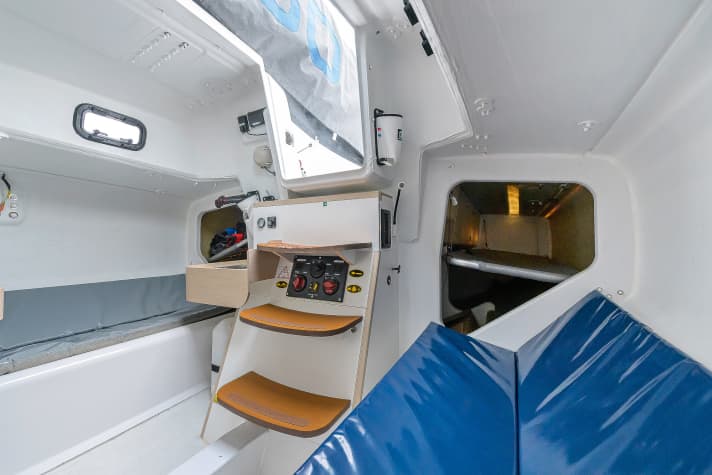
The regatta-orientated focus of the Sun Fast 30 One Design continues below deck. The interior is purely functional, almost unobstructed and completely unadorned. The interior lacks any form of cosiness or even comfort. This is neither to be expected for a boat of this calibre nor desired by the purely sports-oriented clientele. But at least the tubular berths in the stern allow the crew to get some rest on long journeys, and there is also a toilet in the foredeck, which can even be at least partially separated. The shipyard obviously attaches more importance to navigation. The chart table is more functional and the working position is better than on many much larger cruising boats.
A regatta-clear boat costs around 210,000 euros. That's a lot of money for a boat of this size and orientation
In keeping with the standardised class, the price list of options remains correspondingly short. Apart from smaller but necessary items of equipment such as fenders, mooring lines or anchor gear, no further extras are planned for the boat. However, the standard scope of delivery for the basic price of just under 170,000 euros gross still does not include sails, which is normal for performance boats. For the simple set of upwind sails (main and genoa), at least an additional 25,000 euros gross is due. In addition, there are surcharges for the space wind sails such as Code Zero or gennaker. If you want to bring a new Fast 30 One Design to the starting line ready to race, you need to be able to shell out a total of around 210,000 euros.
It remains to be seen whether the Sun Fast 30 One Design can establish itself as a strong and widespread standardised class. One thing is certain: Jeanneau, Multiplast and VPLP have worked together to create an attractive, solid boat.
Measured values Sun Fast 30 OD
Sailing performance
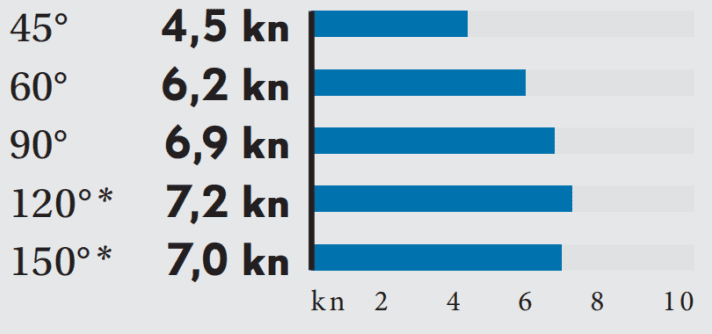
(without drift/current); wind speed: 8 to 10 kn (3 Bft), wave height: smooth water
* with gennaker
Potential STZ* = 5.5

Low weight in combination with plenty of sail area. The sail carrying capacity is correspondingly high
1: Dimensionless number. Calculation: 2√S/3√V. The higher the value, the more sail area (S) the ship has in relation to the displacement (V)
Technical data Sun Fast 30 OD
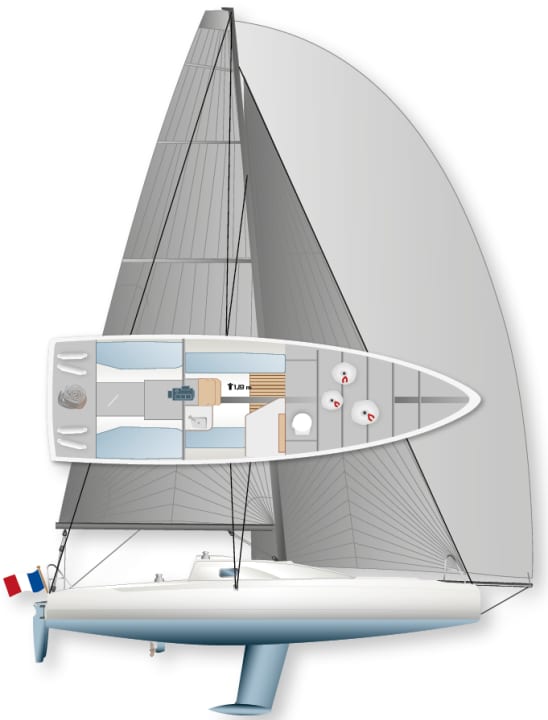
- CE design category: A (4)
- Torso length: 8,99 m
- Total length: 10,40 m
- Waterline length: 8,40 m
- Width: 2,99 m
- Depth: 2,00 m
- Mast height above waterline: 14,10 m
- Theoretical torso speed: 7.0 kn
- Weight: 2,7 t
- Ballast/proportion: 1,0 t/37 %
- Mainsail: 32,0 m²
- Genoa (J2): 27,0 m²
- Gennaker (A2): 105,0 m²
- Reacher (A4): 75,0 m²
- Machine (Nanni): 7.4 kW/10 hp
- Fuel tank (rotomould): 40 l
Hull and deck construction
GRP sandwich with Elium resin, built using the vacuum infusion method (hull with thin Soric fleece, deck with PET foam core). Cast iron keel with a lead ballast bomb
Rig and sail
Carbon fibre rig from Sparcraft Performance with a spreader and Dyform shrouds. The sails are not included in the basic price
Motorisation
The two-cylinder built-in diesel from Nanni with 10 hp output, saildrive and two-blade folding propeller is standard. Optional: electric motor from Bell Marine with pod drive
Electronics
Standard equipment with B&G package (autopilot, GPS, radio, AIS, compass and wind display)
Equipment and prices
- Base price ex shipyard: 169.575 €
- Price ready to sail*: 204.000 €
- Guarantee/against osmosis: 2/5 years
* How the prices shown are defined can be found here!
Shipyard and distribution
Jeanneau/Multiplast; 85505 Les Herbiers (France), www.jeanneau.comDistribution: Dealer network
YACHT review Sun Fast 30 OD
The uncompromisingly realised and innovatively planned One Design should be able to assert itself internationally as a strong standard class. The boat and the concept have the potential to achieve this
Design and concept
- + Consistent implementation
- + Modern construction
- - Relatively expensive in comparison
Sailing performance and trim
- + Very high performance potential
- + Sails unusually stiff
- + Well thought-out cockpit layout
Living and finishing quality
- + Functional interior fittings
- - Sparse and uncomfortable inside
Equipment and technology
- + Carbon fibre rig as standard
- + High-quality equipment
- + Electric motor as an option
Sporty, fast and pretty radical: this is the competition
Aeolos P30
Extravagant design from Aeolos Yachts in the United Arab Emirates. The carbon fibre construction is very light and the boat can also be trailered thanks to its narrow beam and lifting keel option.
- Hull length 9.14 m
- Width 2.91 m
- Weight 1.55 tonnes
- from 141,940 euros
Beneteau Figaro 3
Radical single-handed racer from Beneteau with retractable foils. The Figaro 3 has established itself internationally on a broad basis as a strong standardised class for the single and double-handed scene.
- Hull length 9.75 m
- Width 3.48 m
- Weight 3.1 tonnes
- from 257,040 euros
Dehler 30 OD
The versatile concept, high performance potential and very sporty sailing characteristics characterise the One Design from Dehler. It already has its own class association.
- Hull length 9.14 m
- Width 3.28 m
- Weight 2.8 tonnes
- from 179,570 euros
Pogo 30
An attractive mix of high sportiness for regatta use and touring suitability for cruising with the family. The Frenchwoman is available with a fixed or swivelling keel.
- Hull length 9.14 m
- Width 3.70 m
- Weight 2.8 tonnes
- from 155,580 euros

